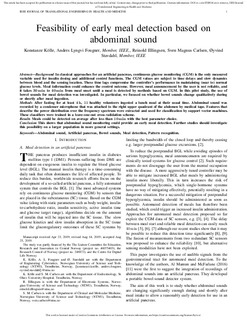| dc.contributor.author | Kölle, Konstanze | |
| dc.contributor.author | Fougner, Anders Lyngvi | |
| dc.contributor.author | Ellingsen, Reinold | |
| dc.contributor.author | Carlsen, Sven Magnus | |
| dc.contributor.author | Stavdahl, Øyvind | |
| dc.date.accessioned | 2019-09-19T12:04:35Z | |
| dc.date.available | 2019-09-19T12:04:35Z | |
| dc.date.created | 2019-08-25T21:49:45Z | |
| dc.date.issued | 2019 | |
| dc.identifier.issn | 2168-2372 | |
| dc.identifier.uri | http://hdl.handle.net/11250/2617675 | |
| dc.description.abstract | Background In classical approaches for an artificial pancreas, continuous glucose monitoring (CGM) is the only measured variable used for insulin dosing and additional control functions. The CGM values are subject to time delays and slow dynamics between blood and the sensing location. These time lags compromise the controller’s performance in maintaining (near to) normal glucose levels. Meal information could enhance the control outcome. However, meal announcement by the user is not reliable, and it takes 30 min to 40 min from meal onset until a meal is detected by methods based on CGM. In this pilot study, the use of bowel sounds for meal detection was investigated. In particular, we focused on whether bowel sounds change qualitatively during or shortly after meal ingestion. Methods After fasting for at least 4 h, 11 healthy volunteers ingested a lunch meal at their usual time. Abdominal sound was recorded by a condenser microphone that was attached to the right upper quadrant of the abdomen by medical tape. Features that describe the power distribution over the frequency spectrum were extracted and used for classification by support vector machines. These classifiers were trained in a leave-one-out cross-validation scheme. Results Meals could be detected on average after less than 10 min with the best parameter choice. Conclusion This shows that abdominal sound monitoring could provide an early meal detection. Further studies should investigate this possibility on a larger population in more general settings. | nb_NO |
| dc.language.iso | eng | nb_NO |
| dc.publisher | Institute of Electrical and Electronics Engineers (IEEE) | nb_NO |
| dc.rights | Navngivelse 4.0 Internasjonal | * |
| dc.rights.uri | http://creativecommons.org/licenses/by/4.0/deed.no | * |
| dc.subject | Biomedisinsk instrumentering | nb_NO |
| dc.subject | Biomedical engineering | nb_NO |
| dc.subject | Type 1 diabetes | nb_NO |
| dc.subject | Tarmlyder | nb_NO |
| dc.subject | Bowel sounds | nb_NO |
| dc.title | Feasibility of early meal detection based on abdominal sound. | nb_NO |
| dc.type | Journal article | nb_NO |
| dc.type | Peer reviewed | nb_NO |
| dc.description.version | acceptedVersion | nb_NO |
| dc.subject.nsi | VDP::Medisinsk teknologi: 620 | nb_NO |
| dc.subject.nsi | VDP::Medical technology: 620 | nb_NO |
| dc.source.journal | IEEE Journal of Translational Engineering in Health and Medicine | nb_NO |
| dc.identifier.doi | 10.1109/JTEHM.2019.2940218 | |
| dc.identifier.cristin | 1718540 | |
| dc.relation.project | Samarbeidsorganet mellom Helse Midt-Norge og NTNU: 46075403 | nb_NO |
| dc.relation.project | Norges forskningsråd: 248872 | nb_NO |
| dc.description.localcode | This work is licensed under a Creative Commons Attribution 4.0 License. For more information, see https://creativecommons.org/licenses/by/4.0/. | nb_NO |
| cristin.unitcode | 194,63,25,0 | |
| cristin.unitcode | 1920,15,0,0 | |
| cristin.unitcode | 194,63,35,0 | |
| cristin.unitcode | 194,65,15,0 | |
| cristin.unitname | Institutt for teknisk kybernetikk | |
| cristin.unitname | Medisinsk klinikk | |
| cristin.unitname | Institutt for elektroniske systemer | |
| cristin.unitname | Institutt for klinisk og molekylær medisin | |
| cristin.ispublished | false | |
| cristin.fulltext | postprint | |
| cristin.qualitycode | 1 | |

